Telangana SCERT TS 6th Class Social Study Material Pdf 6th Lesson From Gathering Food to Growing Food – The Earliest People Textbook Questions and Answers.
TS 6th Class Social 6th Lesson Questions and Answers -From Gathering Food to Growing Food – The Earliest People
(Improve Your Learning)
Question 1.
Why do you think did the earliest people did not wear cotton and woollen clothes? (Conceptual understanding)
Answer:
I think, the earliest people did not know about cotton and woollen clothes. They wore only the skins of dead animals.
Question 2.
What tools would you use today for cutting fruits? What would you do if these tools are not available? (Reflection on contemporary issues and questioning)
Answer:
To cut the fruits into pieces, I would use blade, knife or a simple cutter made of iron and steel. If any one of the above is not available, I would use my teeth to cut it into pieces or else I use any sharp instrument made of wood or stone.
Question 3.
Compare the tools used by the earliest people with those of modem times. (Conceptual understanding)
Answer:
The earliest people used tools that were made of stones, bones, and wood. I.arge stones with sharp edges were used to cut flesh, dig the earth for tubers and hunt animals. They used blades chipped from stones. Today the people use machines, tractors, and sophistïcatetl tools made of steel for various activities.
Question 4.
Why did the earliest people travel from place to place? In what ways are they similar to/different from, the reasons for our travel today? (Conceptual understanding)
Answer:
1. The earliest people lived 1w collecting fruits, flowers, honey, wild grains and edible tubers and roots that grow naturally in the forests and also hunted the birds and animals, but the did not know to grow any crop or rear any animal. The earliest people used to live in small groups in the caves or under trees or rocks. hut they did not build houses.
Reason: In order to gather food or hunt animals, they moved from one place to another in groups.
2. Modern people are well settled They know agriculture. They are well-educated and established industries.
Reason: Some of the modern people also travel from one place to another to earn money for their bread. Business activities are also developed among countries. That’s why the people move from one place to another nowadays.
![]()
Question 5.
locate the following Rock Art sites in the map of Telangana. (Mapping Skills)
A) Asifabad
B) Pandavula gutta
C) Kokapet
D) Durgam
E) Regonda
F) Ramachandrapuram
Answer:
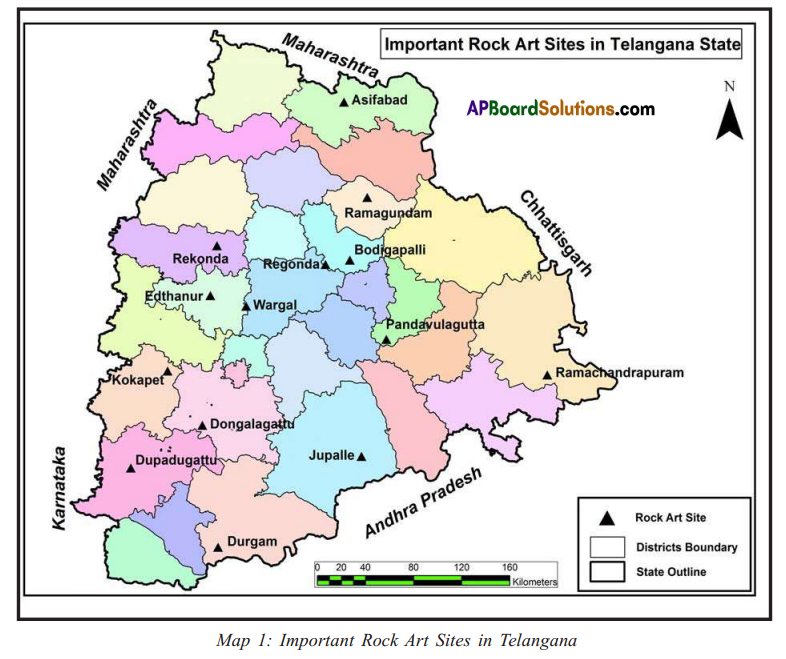
Question 6.
List three ways in which the lives of farmers and herders in present days are different from that of the Neolithic people. (Conceptual understanding)
Answer:
The hunter-gatherers belong to Paleolithic age who lived in caves and gathered plant produce. The farmers and herders belong to Neolithic age, who led a well-settled life.
The three ways in which they were different:
- The fanners and herders led a settled life instead of a nomadic life like hunter-gatherers.
- Generally, farmers ate cooked and well-prepared food, while on the other hand, gatherers ate uncooked food.
- Domestication of plants and animals became part and parcel of the farmers and herders. They became food producers instead of food gatherers and hunters.
- Different types of houses were built by farmers and herders, whereas the hunter –
gatherers lived in caves and under the shadow of trees and stones. - Today the farmers and herders use machines and tractors and tools made of steel etc. The earliest people or Neolithic Age people used the tools made from stones, bones, and wood.
Question 7.
Prepare a list of domesticated animals and agricultural products of the earliest people
and write a few lines about each of them. (Information Skills)
Answer:
Earliest people domesticated the following animals and produced some agricultural products.
| Animal | Used for |
| Sheep | Meat, milk, and wool |
| Goat | Meat, milk |
| Buffalo | Meat, milk |
| Ox | Ploughing |
| Donkey | Carrying loads |
| Cattle | Manuring the soil |
Agricultural products:
| Paddy | Main food crop |
| Wheat | Food crop |
| Barley | Food crop |
| Pulses | Red gram, green gram, black gram, Bengal gram, and horse gram. |
| Millets | Korra, arika, soma etc. |
| Tubers | Eatable roots grown below the earth |
| Vegetables | Ladies finger, donda, brinjal, gourds etc. |
Question 8.
If there was no stove and no grinding stone, how would it affect our food? (Reflection on contemporary issues and questioning)
Answer:
If there was no stove and no grinding stone, the question of cooking the food would not arise, We had to eat the food as it was, and there is no necessity for invention of cooking vessels.
Question 9.
Write five questions that you would like to ask an archeologist to know about the present excavations. (Reflection on contemporary issues and questioning)
Answer:
I would like to ask an archeologist the following questions.
- How is the archaeology useful to know about the past of our ancient people?
- When did the earliest people begin to wear cotton dress?
- Did the ancient people take any drink other than water?
- When did the ancient people begin the growing food?
- How were the ancient people protected themselves from the wild animals?
Question 10.
There are many things in the picture given below. Which of them did not belong to the hunter-gatherers? Which things belong to both the hunter-gatherers and the farmers? Put different signs to distinguish them. (Conceptual understanding)
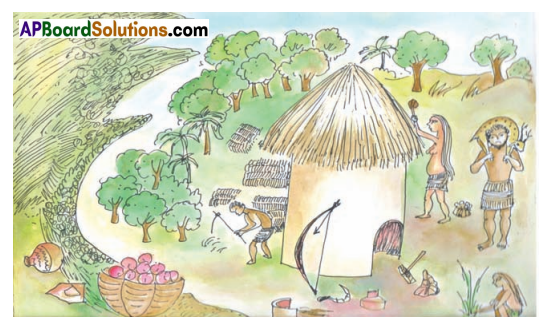
Answer:
Things that did not belong Lo the hunting-gathering people are marked with Y Belonged to both hunting and gathering and agriculturists are marked with XY.
Question 11.
How can you say that the lives of earliest people became easier on domesticating animals? (Appreciation and Sensitivity)
Answer:
1. The method of allowing selected animals to breed and protect them for their own use is called domestication.
2. Early human beings are hunters and food gatherers. On progress of time, with the starting of agriculture, man has started sedentary form of living nearby his agricultural field and also started using animals to help him in his agriculture activities. For example: Ox and cow for ploughing. dog for hunting and protector of the house, horse for traveling distances etc.
3. With the domestication of animals in this way, the lite of man has thus become easier and comfortable.
![]()
Question 12.
Read the paragraph under the heading ‘Nomadic life’ on page no.47 and comment on it. (Reading the text (given), understanding and interpretation)
Nomadic life :
The earliest people used to live in small groups in the caves or under trees or rocks. They did not build houses. Actually, they led a mobile life, constantly moving from one place to another People who regularly move from place to place are called Nomads.
Answer:
- The earliest people moved from one place to another place to save plant and animal resources at those places.
- Animals moved from place to place – either in search of smaller prey or in the case of deer and wild cattle in search of grass and leaves. That is why, those who hunted them had to follow their movements.
- Plants and trees bear Fruit in different seasons. So, people might have moved from season to season in search of different types of fruits.
- People. plants and animals need water to survive. Water is found in lakes, streams, and rives. So, people living on seasonal lakes, streams, and rivers. So, people living on seasonal rivers banks would had to go in search of water during the dry seasons.
Activity:
Question 13.
Solve the crossword puzzle using the clues given below. (Information skills)
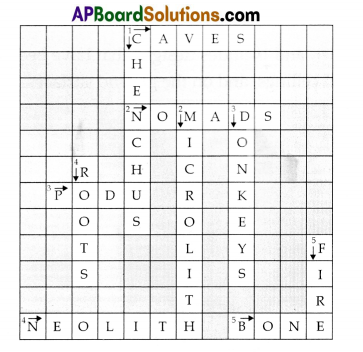
Clues:
Across:
1. These were the shelters of the earliest people (5).
2. These people regularly move from one place to another (6).
3. Shifting agriculture (4).
4. A new kind of stone tool developed by the earliest people (7).
5. This was also used by the earliest people to make their tools (4).
Down:
1. These people are called hunter-gatherers in our times (8).
2. A small piece made from a hard stone (9),
3. These animals were used to cam’ heavy loads and plough their fields (7).
4. The earliest people collected this to eat (5).
5. Flesh of animals was roasted with this (4).
Answer:
Solution:
Across:
1. CAVES,
2. NOMADS,
3. PODU,
4. NEOLITH,
5. BONE
Down:
1 CHENCHUS
2. MICROLITH,
3. DONKEYS.
4. ROOTS,
5. FIRE
(PROJECT)
Find out if there are any rock painting sites near your place and visit them with your class. Write a report on it and present in your class.
PANDAVULA GUHALU
We live in Warangal district We have I’andavuta Cuhalu in our district which belonged to 1000 B.C. Warangal district consists of many prehistoric habitation sites, which were explored by the Indian Archaeological authorities. Paleolithic rock art paintings are found at Pandavula gutta (Regonda) and Narsapur (Tadvai) in the district. The paintings on rock shelters at Narsapur and Bandal of Tadvai mandaI in Warangal district were dated to megalithic times of 1,000 BC. Rock art is a form of landscape art, and includes designs that have been placed on boulder and cliff laces, cave walls and ceilings, and on the wound surface.
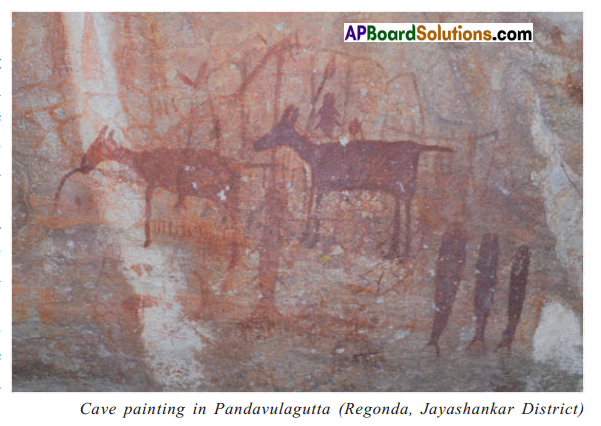
The figures depicted in the paintings at these hills are of peacocks, lizards, tigers, frogs, fishes, deer, etc.. and geometrical designs and impressions in green. red, yellow, and white pigment colours. Besides these rock painting,s. inscriptions of Rastrakutan times and fresco paintings 0f late medieval period have also been reported from these hillocks. Some of the paintings were superimposed, depicting highly developed anatomical features and curves.
(In-text Questions)
Text Book Page No. 45

1. In the above figure, how are the people gathering their food?
Answer:
- A man is plucking fruits from a tree with a long stick.
- One woman is fishing.
- Another woman is digging tubers.
- One more woman is bringing the gatherings from forest in a basket.
- One man is carrying food items on his shoulder.
Question 2.
What types of clothes are they wearing?
Answer:
The people are wearing clothes made from leather and wild leaves.
Question 3.
You will find five or six types of tools and weapons in the above picture. Can you Identify them?
Answer:
1) Stick
2. Sickle
3) Crowbar
4) Hunting stick
5) Basket
6) Fruit basket
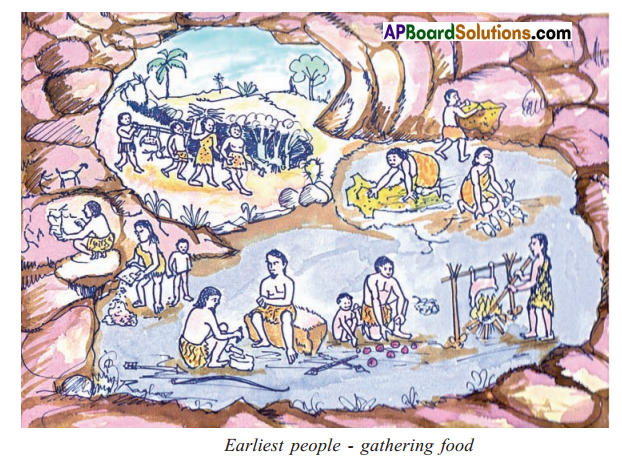
Look at the above Picture:
Question 4.
What have the men and women brought from the forests?
Answer:
- One man is carrying bundle of sticks on his head.
- Two people are carrying a dead animal that hanged to a stick on their shoulders.
Question 5.
Describe the work they are doing in this picture.
Answer:
- One woman is frying the dead animal.
- One woman is drying the fish.
- Another woman is cleaning the skin of the dead animal.
- One woman is spreading the cereal food on the floor.
- One man is making a weapon.
- One man along with his child is fishing.
- One man is drawing a picture.
Question 6.
Can you list the food items that you eat which are not grown but collected from the wild? How do you prepare them for eating?
Answer:
Some of food items collected from the wild are:
- Tamarind
- Honey
- Lemon
- Amla
- Herbal medicines
- Fruits etc.
We prepare them for eating by a suitable process.
Text Book Page No. 4
Question 7.
Can you think of the differences and similarities between the food habits of the earliest people and your own food habits?
Answer:
Comparison of Food habits
| Earliest People | Present People |
| Similarities:
1) They ate raw flesh. |
Similarities : 1) They eat cooked and processed flesh. |
| 2) They ate fruits, roots, tubers and vegetables. | 2) The modern people also take vegetables, fruits, roots, and tubers etc. |
| Differences: 1) They ate raw flesh. |
Differences: 1) These people also eat flesh after processing and cook It with spices, oil, etc. |
| 2) Earliest People did not know about ‘Fast Foods’. | 2) These people are taking fast foods made with bread, vegetables, spices etc. |
| 3) They did not know various types of fruits and vegetables. | 3) These people knew about so many varieties of fruits and vegetables which are available in plenty. |
![]()
Question 8.
Do you think they could have worn clothes like you? What do you think did they wear?
Answer:
I dont think they could have worn clothes like me. The earliest people wore the dress made of leather of wild animals like tigers, lions,s, and deer. They did not know about the cotton or silk clothes what we wear today.
Text Book Page No. 47
Question 9.
For what purposes are stones used by people today?
Answer:
Today the people are using stones for various purposes.
- Building constructions
- Flooring in houses
- Grinding mills
- Making idols
- Paying the roads
- Small stones and gems in jewellery items.
Question 10.
Today, what do we use fire for?
Answer:
Nowadays we use fire for cooking mainly. We use fire in melting works, foundries to melt metal like iron, steel, gold, and silver, etc. We use fire to keep our bodies heat in winter resort We use (ire for light when power suddenly goes off. We use lire in Thermal stations to burn coal. Previously the fire was used to burn coal in steam engines in Railways. Now it became an old fashion.
Question 11.
Can you guess the reasons for early people’s continual movement from one place to
another?
Answer:
In searching of food and water the earliest people moved from one place to another constantly.
a) What will happen If a group finishes all the fruits or animals of an area?
Answer:
If a group of persons consumed the fruits and animals, the area became empty. There will be no food for them. So they have to vacate the area.
b) Do animals stay in the same place or do they keep moving?
Answer:
As they could not find food, the animals also had to move to some other places.
c) Will water be available in the same place throughout the year?
Answer:
No, it is not.
Question 12.
Even today many people migrate from one place to another. What things do they carry with them while shifting?
Answer:
Those people who migrate to foreign lands for education. jobs etc. take their certificates, risa, permission. clothes, utensils, durable food items with them. Those people who shift for livelihood, business, take their household articles along with family members.
When people are moving to some other places for temporary purposes. occasions, excursions, we will take money. necessary articles belong to us.
Question 13.
When the earliest people were migrating, what might they have carried with them?
Answer:
When the earliest people were migrating, they would have carried their hunting instruments, stone tools and skins of animals with them.
Question 14.
Why are people in present times are not leading a nomadic life? Why do they built houses and live in the same place?
Answer:
There is no need for the people in present times to lead a nomadic life. There is no problem for food, water, and shelter. There are ample medical facilities, transport facilities, oh opportunities. educational facilities. They got each and everything. So, people need not migrate to any place.
![]()
Text Book Page No.48
Question 15.
Look at the following picture of paintings on the rock shelter in Pandavulagutta. What do you see? Describe the pictures carefully. Can you see that some of the pictures are painted on an earlier painting. Why do you think they painted on old paintings?
Answer:
The figures depicted in the paintings at these hills are of peacocks. ards, tiger, frogs, fish, deer etc., and geometrical designs and impressions in green. red. ‘yellow and white pigment colours. Besides these rock paintings inscriptions of restoration times and fresco paintings of late medieval period have also been reported from these hillocks. Some of the paintings were superimposed. depicting highly developed anatomical features and curves.

Text Book Page No. 48
Question 16.
Do people in your Community draw pictures or designs as a part of festivals and religious rituals?
Answer:
Yes, the people in our Community draw pictures or designs as a part of festivals and religious rituals using different colours. Eg Bonalu ; Sankranthi. Vinayaka Chavithi and New Year occasions.
Question 17.
Find out from your teacher about such sites in your own district and visit those places. Look for stone tools in the museum in a nearby town.
Answer:
Student Activity.
Question 18.
Look at the picture 6.9 of paintings on the rock shelter in Pandavulagutta. What do you sec? Describe the pictures carefully. Can you see that some of the pictures are painted on an earlier paintings. Why do you think they painted on old paintings?
Answer:
- Paintings on the rock shelter in Pandavulaguita were deer, one goat. cows, mongooses, peacocks. butterfly, geometrical signs. human figures and horse riders
- Some of the pictures are painted on an earlier painting because the people of pre-historic age have passed these methods to the future generation.
Question 19.
What is the colour of the paintings? Can you find out what materials they may have used for making these paintings the colours and brushes?
Answer:
- The colours of the paintings are red, white, yellow, green, and human.
- They used different coloured stones were ground and tried with animal fat. Pictures were painted on rocks with bamboo brushes.
Question 20.
look at the map given below to identify the rock art sites in your district.
Answer:
I live in Mahabooba nagar district. Dongalagatlu, Dupadugattu, and Durgam are the rock art sites in our district.
Text Book Page No. 49
Question 21.
What is the colour of the paintings? Can you find out what materials they may have used for making these paintings – the colours and brushes’
Answer:
- The material that may have used for making these paintings were different coloured stones were ground and mixed with animal fat.
- They used bamboo brushes.
Question 22.
Look at the map given below to identify the rock art sites in your district.
Answer:
I live in Khammam districi. I found only one rock art site in my district that is in Rama Chandrapuram.
Text Book Page No. 51
Question 23.
Why couldn’t the early people store food for a long time?
Answer:
There was not much scope for storage of food as it consisted mainly of perishable things like meat, Fish, fruits, leaves, tubers, and small quantities of wild grains. There were no bars and tins to store them for months. They couldn’t have modern facilities like refrigerators. So, the early people couldn’t store the food for long time.
Question 24.
Do you think it would have created any problems if the hunter-gatherers did not share their food?
Answer:
I think the following things would happen when the hunter-gatherers did no4 share their food.
- The remaining food will perish if they were not taken fully.
- The wildlife will be completed earlier.
- Fruits, tubers, and vegetables will disappear completely.
Question 25.
Why were there no poor people among them?
Answer:
Since the ancient people shared all the food and had tree access to the resources of
the forests, hunter-gatherers did not have an rich or poor among them. They were all equal and treated each other equally.
Question 26.
Do you find any similarity between thanking the killed animal by the earliest people and worshipping the harvest by the farmers nowadays?
Answer:
The hunier-gatheres had a great respect and regard for the forests, the plants and trees, the animals. risers and hills. They often worshipped them that they mae get enough food all the time. But thee did not know the God. The farmers, now-a-days, worship the god before starting the agricultural activities to avoid the interruptions like cyclones, heavy rains, tire accidents, etc. They render offers to the God alter getting the crops from the fields. They perform festivals of thanks giving.
![]()
Text Book Page No. 52
Question 27.
Do farmers still use domestication method to select better seeds for the next year?
Answer:
Yes. I think so. They select better seeds for the next year.
Question 28.
How do you think people protect the crops they select to sow?
Answer:
People usually select the seeds that give good yields, When the people sow selected crops and protect them till they bear fruit. They took extra care about the water facility against the calamities of rain. They use fertilisers to raise the crop yielding. The use pesticides also to remove the bad germs. In these ways the people protect their crops.
Question 29.
How do the people protect the animals they want to breed?
Answer:
The people select the animals that give good yields and are not prone to disease etc. Only animals of selected type are allowed to breed and protect them for their own use, They protect the animals from wild animals and diseases, When they fall sick, take them to dispensaries for cure.
Text Book Page No. 53
Question 30.
How do you think the early people stored grains?
Answer:
When staying at one place. because inevitably, they constructed huts. Vessels were needed to slore and cook grain. It led to the making of pots of different kinds They stored the over-roasted grains in various pots.
Question 31.
Why do people who grow crops have to stay in the same place for a long time?
Answer:
The people who grow crops have to stay in the same place for a long time because there is no need to gather the food by wandering in woods. They knew agriculture well. All the herders began to sow the seeds and got good yields. They constructed the house or hut and settled for long time.
Question 32.
Imagine and draw the huts used by the earliest people. How are they different from
your homes.
Answer:
A hut made of mud, wood, and leaves. Our homes are made of concrete, brick and cement.

Differences between their huts and our homes.
| Huts | Homes |
| 1. Earliest peoples’ houses are huts. They were made of mud, wood, and leaves. | 1. Present peoples’ houses are, made of brick with concrete roofs. |
| 2. Their floor is purely mud. | 2. Our’s floor is mosaic. |
| 3. There were no separate rooms. No power supply. | 3. There are separate rooms with power and water supply. |
| 4. There were no drainage facilities. | 4. Well furnished with drainage facilities. |
| 5. They are small in size. | 5. Our homes are big in size. |
Additional Questions
Question 1.
Observe the following table carefully and answer the following questions. Siles of Neolithic Age where grain and bones are found.
| Grain and Bones | Sites |
| 1.Wheat, barley, sheep, goat, cattle. | Mehrgarh (in present-day Pakistan). |
| 2. Rice, fragmentary animal bones. | Koldihwa (present in Uttar Pradesh). |
| 3. Rice, Cattle (hoof marks on clay Surface). | Mahagara (Present in Uttar Pradesh). |
| 4. Wheat and lantil. | Gufkral (in present-day Kashmir). |
| 5.Wheat And lantil, dog, cattle, sheep, Goat,buffalo. | Burzahom (in present-day Kashmir). |
| 6. wheat, green gram, barley – buffalo,Ox | Chirand (in present-day Bihar). |
| 7. Millet – cattle, sheep, goat, pig. | Hallur (in present-day Andhra Pradesh). |
| 8. Black gram, millet – cattle, sheep, pig. | Paiyampalli (in present-day Andhra Pradesh). |
1. Where is rice grown more during Neolithic age?
Answer:
Koldihwa and Mahagara arc the two places where rice is mostly grown.
2. Where were fragmentary animal bones found?
Answer:
Koldihwa (Uttar Pradesh)
3. What are the two sites found in Kashmir State?
Answer:
Gulfkral and Burzahom are the two places in Kashmir.
4. Name the two sites of Neolithic Age in Telangana.
Answer:
Warangal, Mahahuhnagar and Adilabad district.
5. Name all the animals of which their hones mentioned in the table.
Answer:
Sheep. goat. cattle, dog. buffalo, etc.
2. Observe the following table carefully.
Answer:
| Stone tools | Found in Excavated places |
| 1. Earliest stone tools | Amarabad, Mahaboobnagar Dist. |
| 2. Blades chipped from stones | Yeleswaram, Nalgonda Dist. |
| 3. Tools made from stone flakes | Amarabad, Mahabubnagar Dist. |
| 4. Microliths | Ghanapur, Adilabad Dist. |
| 5. Animal bones, stone tools | Belum caves, Kurnool dist. |
Now answer the questions:
1. What are the two items of stone tools found in Mahaboob Nagar district?
Answer:
Earliest stone tools and tools made from stone flakes.
2. Where were the microliths are found?
Answer:
Ghanapur (Adilabad)
3. For what Belum caves arc famous?
Answer:
For Animal bones
4. What were found in yeleswaram excavations?
Answer:
Blades chipped from stones.
Question 3.
Observe the following picture carefully and write down about the figure.
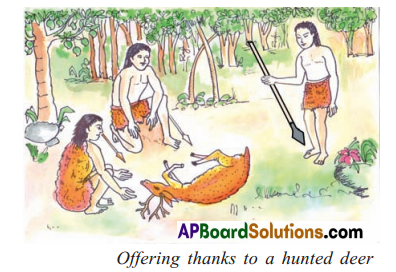
Answer:
This picture is about ‘offering thanks to a hunted deer by the earliest people’ taken from the lesson ‘Trom gathering food to growing food’. Even though they hunted wild, animals hunter-gatherers had a great respect and regard for the forests, the plants and trees, the animals, rivers, and hills, they often worshipped them so that they may get enough food all the time.
Question 4.
Write about the lifestyle of the earliest people?
Answer:
Thousands of years ago all people lived by collecting fruits, flowers, honey, wild grains and edible tubers and roots, and hunted birds and animals. They did not grow any crop or war any animal The earliest people also used tools; hut these were made of stones, bones, and wood. After thousands of ears the’ bogan to make fine, small pieces Iron hard stone. These pieces were called micro liths’. The discovery of fire by the early people brought about great changes in their lives. Fire enabled them to eat roasted meat in place of raw flesh, ‘Archaeologists are people who study the past by digging up old places where people lived and taking out remains of their lives like tools, bones, pots, buildings, etc, The earliest people used to live in small groups in the caves or under trees or rocks.
Actually they’ led a mobile life’. number of Neolithic sites have been found in Warangal, Karimnagar, Mahahubnagar, and Adilabad districts. People seem to have lived here about 3300 years ago. The early people drew pictures of animals and hunting scenes on the walls of many caves and rock shelters. Pictures were then painted on rocks with bamboo brushes. Even these days several groups of people live by hunting and gathering food.
In our own state the Yanadis and Chenchus till very recently lived in this manner. lunter gatherers shared the food the’ collect with all the members of the group. Since they shared all the food, they did not have any rich or poor among them. This system is called ‘shared living’.
![]()
Information Skills
Question 5.
Read the given information and answer the questions in one or two words.
| Animal | Used for |
| 1. Sheep | Meal, milk, and wool |
| 2. Goat | Meat, milk |
| 3. Buffalo | Meat, milk |
| 4. Ox | floughing |
| 5. Pig | Meat |
| 6. Dog | Domesticated for safety |
| 7. Cattle | Used In Agriculture |
1. What animals are used for meat and milk?
Answer:
Sheep, goat, and buffalo.
2. What are used in agricultural activities?
Answer:
Cattle
3. Why is dog domesticated?
Answer:
Domesticated for safety
4. What is the animal used for ploughing?
Answer:
Ox
5. Which animal is reared For meat only?
Answer:
Pig
(Mapping Skills)
Question 6.
Map Pointing
Locate the following Rock Art sites in Telangana.
1) Asifahad
2) Regonda
3) Ramachandrapuram
4) Dongalagartu
5) Ramagundam
Answer:
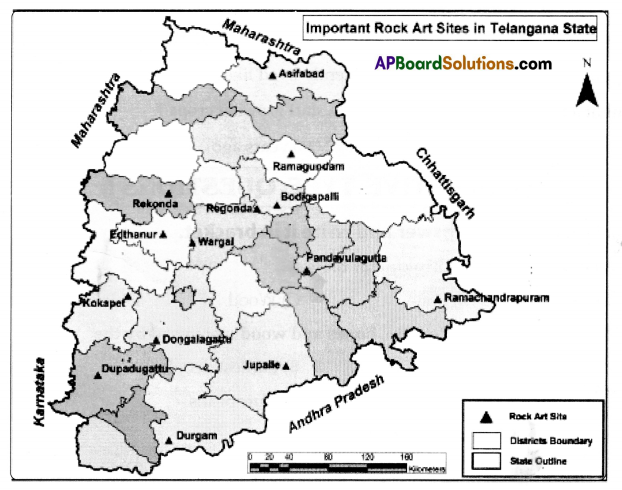
Two Mark Questions
Question 1.
What were the main occupations of the early man?
Answer:
Food gathering and hunting were the main occupations of the early man.
Question 2.
What kind of clothes did the early man wear?
Answer:
The early man used to wear the clothes made up of animal skin and leaves of trees.
Question 3.
What kind of tools did the early man use?
Answer:
The early man used the tools made up of stones, bones and wood.
Question 4.
What were ‘microliths”?
Answer:
Microliths were the fine and small pieces of stone weapons made from hard s-tone.
Question 5.
What was the greatest invention of the early man?
Answer:
The invention of fire was the greatest invention of the early human beings.
Question 6.
What were the uses of fire?
Answer:
The fire was used-
- to roast the meat
- to keep off the wild animals
- to provide light in the caves.
Question 7.
How did the early man expressed his views?
Answer:
He expressed his views by drawing pictures of animals and hunting scenes on the walls of caves and rock shelters.
Question 8.
Name the tribes who lived like the early man in our state till recently.
Answer:
The Yanadis and the Chenchus till recently lived like the early man.
Question 9.
When did the hunter-gatherers begin to start growing crops?
Answer:
They began to grow crops only about 12,000 years ago.
Objective Types Questions
Question 1.
Nowadays we use this kind of tools. ( )
A) Stone
B) Bone
C) Wood
D) Iron and Steel
Answer:
A) Stone
Question 2.
The tools made from stones, bones, and wood were used by the ( )
A) Modern people
B) Earliest people
C) Foreigners
D) Europeans
Answer:
B) Earliest people
Question 3.
The small pieces made from large stones are ( )
A) Masterpieces
B) Microliths
C) Neoliths
D) Sickles
Answer:
B) Microliths
![]()
Question 4.
The discovery of this brought about great changes in the lives of early people. ( )
A) Water
B) Sickle
C) Fire
D) Agriculture
Answer:
C) Fire
Question 5.
The earliest people used to live in ( )
A) Caves
B) Buildings
C) Huts
D) Forests
Answer:
A) Caves
Question 6.
People who regularly move from place to place are called ( )
A) Villagers
B) City public
C) Nomads
D) Pedestrians
Answer:
C) Nomads
Question 7.
Hundreds of Neolithic sites have been found in this district ( )
A) Warangal
B) Kanmnagar
C) Mahabubnagar
D) All the above
Answer:
D) All the above
Question 8.
The early people used this to paint on the rocks ( )
A) Nylon brush
B) Toothbrush
C) Bamboo brush
D) Stone piece
Answer:
D) Stone piece
Question 9.
Large number of Microliths handmade pots and jars are found in this district ( )
A) Warangal
B) Adilabad
C) Karimnagar
D) Mahabubanagar
Answer:
A) Warangal
Question 10.
The recent hunter-gatherers who are seen in Telangana are ( )
A) Lambadis
B) Chenchus
C) Yanadis and Chenchus
D) Thotis
Answer:
C) Yanadis and Chenchus
Question 11.
They were all equal and treated each other equally. Who are they? ( )
A) Hunter-gatherers
B) Earliest people
C) Wild people
D) Modem humans
Answer:
D) Modem humans
![]()
Question 12.
The herders used oxen for ( )
A) Carrying loads
B) Ploughing the fields
C) Milk
D) Meat
Answer:
B) Ploughing the fields
Question 13.
Shifting agriculture is known as ( )
A) Padu
B) Podu
C) Nadu
D) Paddy
Answer:
B) Podu
Question 14.
Grain had to be stored by the people for ( )
A) three months
B) six months to one year
C) Long periods
D) one to two years
Answer:
B) six months to one year
Question 15.
A new kind of stone tool is known as ( )
A) Neolith
B) Mesolith
C) Palacolith
D) Lithosphere
Answer:
C) Palacolith
Question 16.
The reason to find out fire by man ( )
A) Migration from on place to another place
B) To cook food
C) For hunting
D) For agriculture.
Answer:
B) To cook food
Question 17.
Hunters began to rear cattle because ( )
A) For agricultural activities
B) For flesh and meat
q To fight with other gatherers
D) To get dung ash
Answer:
B) For flesh and meat
![]()
Question 18.
Settled people made stones for the purpose of ( )
A) cutting trees
B) killing animals
C) grinding corn
D) cooking food
Answer:
B) killing animals
Question 19.
The natural vegetation turned into grasslands due to ( )
A) warmer climate
B) cold climate
C) increased necessity
D) Clearance of forests
Answer:
D) Clearance of forests
Question 20.
Why do people who grow crops have to stay in the same place for a long time because ( )
A) there is no need for gathering food by wandering
B) they did not know agriculture
C) they did not want to settle
D) they may lose their relatives
Answer:
A) there is no need for gathering food by wandering